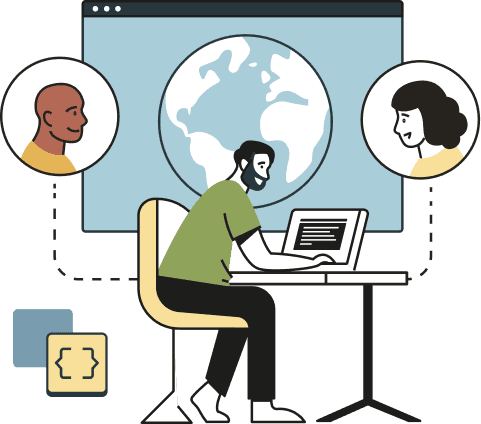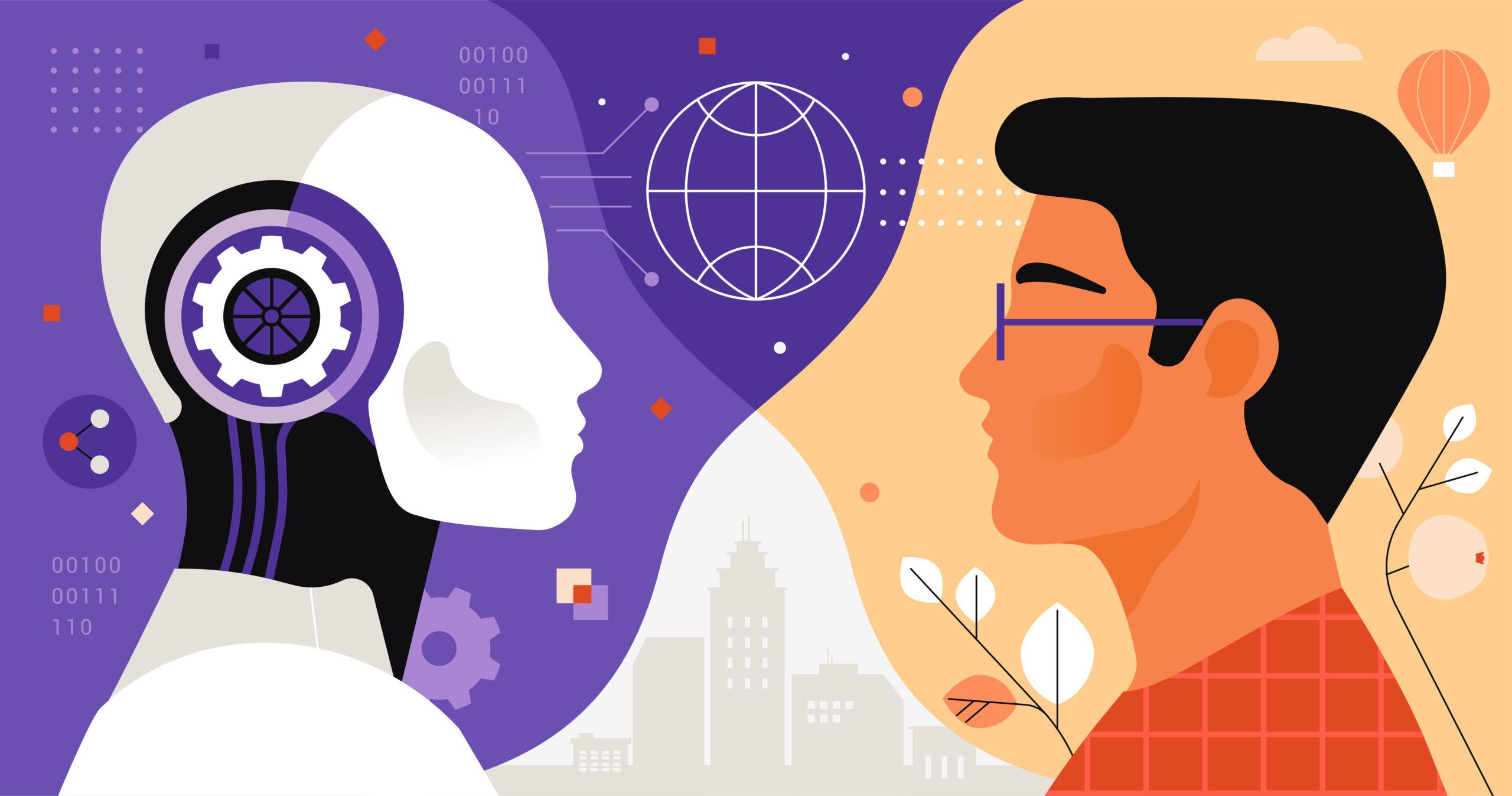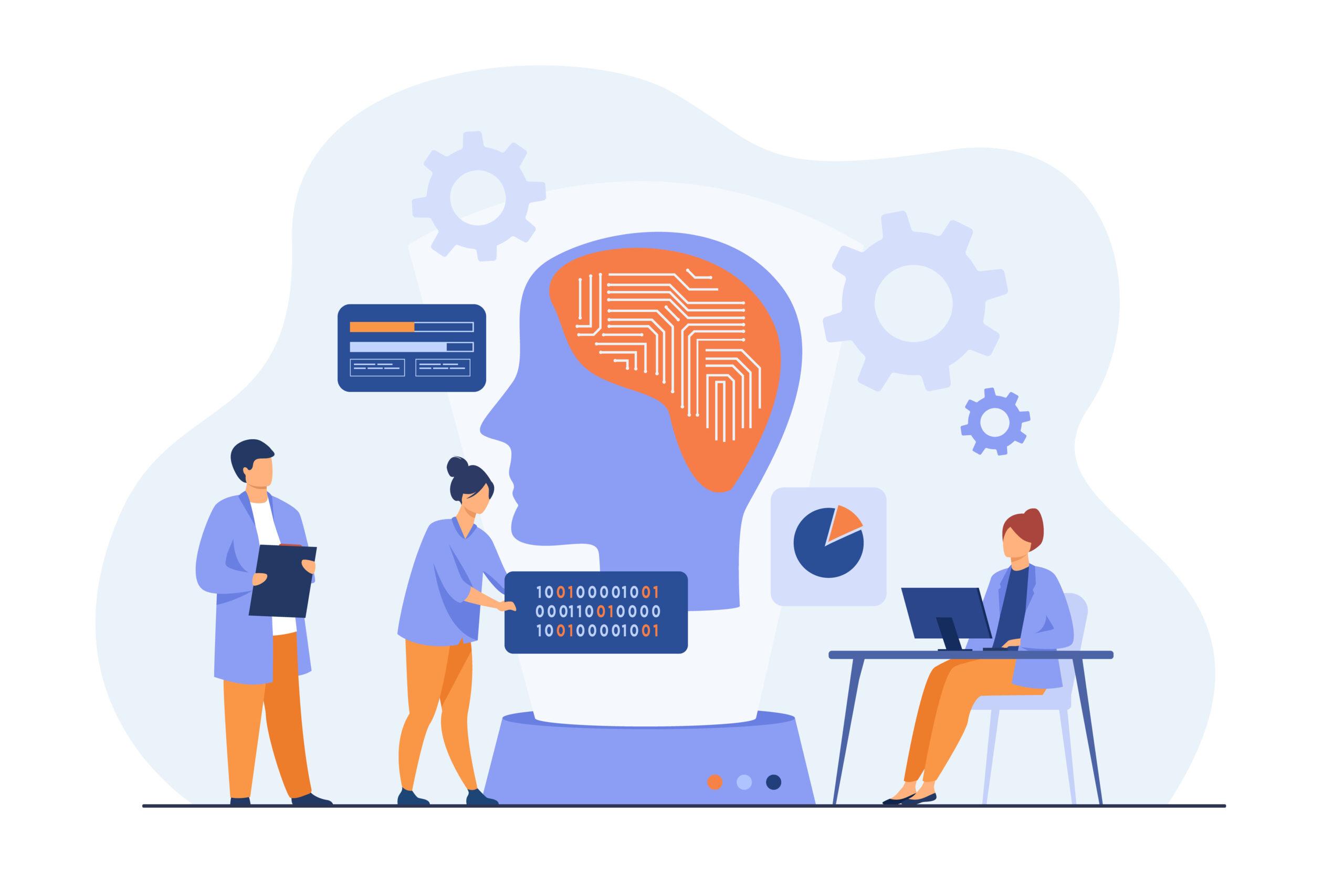
Demand | Blog Post
Algorithms & Interviews: The Smart Guide to Hire AI & ML Developers
Kira Sparks
Share this post
Artificial Intelligence (AI) and Machine Learning (ML) aren’t just tech trends — they’re reshaping how we approach product development from the ground up. 56% of companies have already incorporated AI into their product or service lineup, and those who do so are grabbing VC attention. Generative AI products received 5x more investment dollars than last year.
But, as more businesses bring AI-fueled products and features into their roadmaps, they’re facing a major hiccup: the AI talent crunch. The demand for AI and ML developers in the US is expected to skyrocket by 300% over the next two years. Natural Language Processing (NLP) and Large Language Models (LLM) skillsets are in especially high demand, with companies increasing their adoption of SaaS LLM APIs by 1310% since 2022.
Given this escalating demand and low rates of tech unemployment, companies face an uphill battle in securing the right tech talent to scale their products.
And, it’s not getting better anytime soon: The AI market is projected to hit $407 billion by 2027. Developing an effective hiring approach now is critical for building the team of tomorrow.
In this guide to hiring AI & ML developers, you’ll find insights into the AI talent landscape, strategies for sourcing and interviewing devs, and best practices in managing and nurturing talent. We’ll help you hire an AI developer effectively and ensure long-term success.
Part One: Decoding the AI/ML developer profile
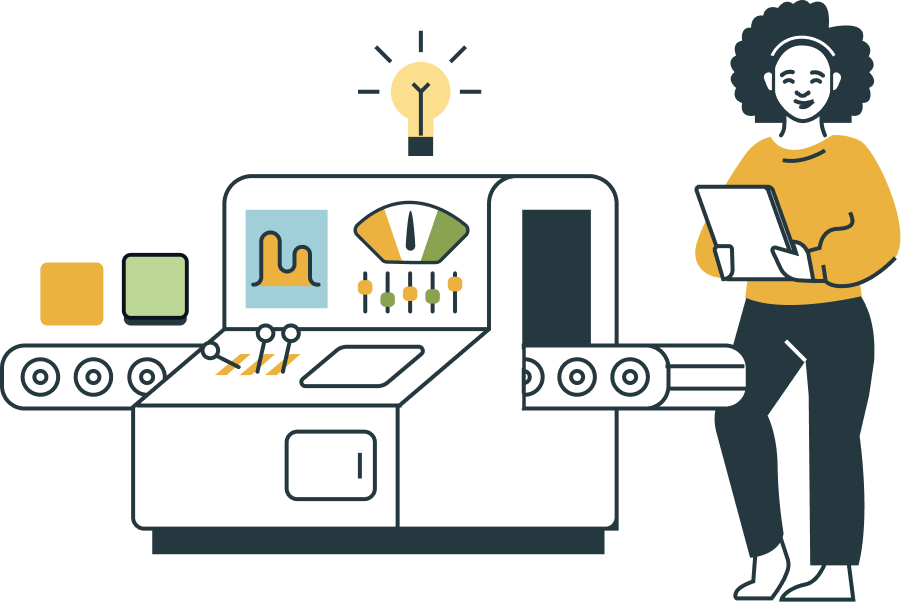
Not all AI products, or AI developers, are created equally. The field is broad and the skills you need might vary based on what you’re building.
So, where do you start? Take a hard look at your product requirements. Then, you can match them with the appropriate recruitment objectives. This ensures you’re not just hiring talent, but the right talent.
AI Developer Skills Cheat Sheet
If you’re building…
| AI Integrations, (e.g. connecting to ChatGPT’s API) | Products that run ML models on top of big data sets | Your own LLM |
|---|---|---|
| Skill level: Intermediate to beginner. The developer will mainly interface with a pre-built API rather than creating an AI model from scratch. | Skill level: Advanced. Developers should be adept at not only integrating models but creating, training, and tuning them. | Skill level: Expert. Building a custom LLM is a significant effort that requires a deep understanding of the underlying principles of language modeling. |
| Technical AI skills: Proficiency in programming languages commonly used for API integration, such as Python or JavaScript. | Technical AI skills: Expertise in machine learning libraries (like TensorFlow, PyTorch, or Scikit-learn), big data technologies (like Hadoop or Spark), and cloud platforms for scalable compute resources. | Technical AI skills: Mastery of deep learning libraries, such as Tensorflow, Pytorch, Caffee, and MxNet and other ML libraries, such as Scikit-learn. |
| Training: Previous experience working with ChatGPT’s API and understanding of its capabilities, interfaces and limitations. | Training: Deep knowledge in various machine learning algorithms, optimization techniques, and strategies to handle big data efficiently. | Training: Expertise in distributed computing for training large models and efficient data storage and retrieval mechanisms. |
Beyond the technical: soft skills for AI developers
Successful AI recruiters also vet for soft skills — the personality traits and behaviors that influence job performance and success.
In the age of AI, development isn’t just about understanding algorithms and code. It’s about clear communication amidst complexity, an endless drive to explore new terrain, and the resilience to keep at it, for as long as it takes. Soft skills aren’t just a bonus – they are a developer’s compass.
Tess Manderson, VP of Talent, Terminal
Here are a few of the essential soft skills for AI developers:
💬 Communication
Given the intricate nature of AI projects, developers need to communicate challenges clearly and coordinate effectively with multi-disciplinary teams. This keeps everyone, from data scientists to product managers, aligned.
- Interview questions to ask:
- Describe how you’ve communicated a complex AI challenge to a non-technical team.
- Share a time when there was misalignment with another team. How did you resolve it?
🧐 Problem-solving mindset
The world of AI is ever-changing. Developers must venture into new areas without a set guide (there’s no guarantee you can Google trouble-shoot this one!). This makes a knack for problem-solving a must-have.
- Interview questions to ask:
- Tell me about an AI challenge you faced without readily available online resources. How did you tackle it?
🚴 Patience and perseverance
Training an AI model is an ongoing process. Developers must be prepared for a cycle of testing, tweaking, and refining, requiring both patience and a drive to see projects through to the end.
- Interview questions to ask:
- Share an instance when an AI model you trained didn’t meet expectations. How did you respond?
- Describe a situation where an AI project veered off course. How did you adapt and find a solution?
Skills required for AI developers + hiring insights
Get to know the skills required for AI developers and help shape your perfect team:
🧠 Deep Learning
- What it is: Deep learning, a subset of machine learning, is a neural network with three or more layers (hence, the “deep”). It’s inspired by the structure and function of the brain, particularly how the brain processes information through interconnected neurons.
- How it’s used: It powers numerous AI applications, from everyday products like digital assistants to emerging technologies like self-driving cars.
- What to look for: Developers who have experience building and tuning deep neural networks and also understand the underlying mathematics and model optimization.
- Titles: Data Engineer, Machine Learning Engineer, Machine Learning Scientist
🗣 Natural Language Processing (NLP)
- What it is: NLP uses rule-based language modeling and artificial intelligence to help computers interpret and understand languages just like humans.
- How it’s used: Beyond chatbots, translation tools, and sentiment analysis, NLP is used for tasks like text summarization, topic modeling, and language generation.
- What to look for: In addition to strong programming chops, NLP developers need a deep understanding of linguistics, probability, statistics and common NLP problems and tools (e.g. parsing, POS tagging, Named Entity Recognition, classification, etc.).
- Titles: NLP Engineer, Computational Linguist, ML Engineer, NLP Data Scientist
👁 Computer Vision
- What it is: Computer vision is the science and technology of making machines see. It allows machines to interpret and make decisions based on visual data.
- How it’s used: Apart from facial recognition and autonomous vehicles, computer vision is used in areas like augmented reality, object detection, and medical image analysis.
What to look for: Developers who are adept at using convolutional neural networks, understand image processing and have experience with libraries like OpenCV or Pillow.
🖥 Common AI Programming Languages
Here’s a few programming languages to look for among AI/ML developers:
- Python
- Julia
- C/C++
- Java/Scala
- Swift/Javascript
- R
- Go
Structuring your AI development team
Developing AI systems requires a blend of specific skills and expertise. Carefully plot out your team’s structure as you hire AI & ML developers so that you can hire strategically for the product you’re building. While the exact makeup of teams may differ, there’s core functional areas you may consider building out:
Data team
As custodians of the prized asset (data!), this team is often the backbone of an AI organization. Consisting of Data Scientists who uncover patterns, Data Engineers who architect and maintain pipelines, and Machine Learning Engineers who implement algorithms, this team keeps data flowing effectively and informs decision-making.
Algorithm team
If data is the raw material, algorithms are the machinery that process it. This team, composed of Deep Learning and Machine Learning Engineers, designs, tests, and refines the algorithms that form the essence of AI systems.
Infrastructure/Platform team
This team protects the scalability, reliability, and efficiency of the tools and systems that AI applications rely on, from Backend Software Engineers who create the systems’ architecture to DevOps and MLOps engineers who streamline the development and deployment processes, and System Engineers who keep it all running smoothly.
Part Two: Sourcing and interviewing AI engineers

Why you should look globally for AI/ML developers
The demand for engineering talent, especially candidates skilled in AI/ML, is growing by the day. It’s a highly specialized skill set, which means it may not be easy to hire the AI & ML developers you need in your backyard. That’s where global hiring comes in.
Global markets are rich with talent and innovation. In Terminal’s State of Engineering Report, 75% of engineers living in these markets say they’re eager to be part of US tech enterprises. But, they don’t necessarily want to move to do so. Two-thirds say they want to stay fully remote.
Global teams bring a diversity of ideas, cultures and skills that can be an asset to your organization. What’s more, two-thirds of workers report feeling more productive when working remotely. And, you may also see some economic efficiency for your budget when hiring lower-cost, but high-quality talent outside expensive tech hubs.
Living in Austin, Texas, we’ve faced challenges like skyrocketing salaries and the race to secure talent. It was crucial for us to tap into global markets not just to find talent, but diverse talent. This is why we moved to global. My team is now 35% women, which is something I’m really proud of – it’s incredibly diverse and it’s the best team I’ve ever built.
Nick Parker, CTO, Everly Health
Key AI hiring markets: Canada, Europe, Latin America

Canada
Renowned as an AI and ML behemoth, Canada is home to nearly 35,000 professionals. According to Stanford’s 2023 AI Index Report, Canada had the second-highest penetration of AI job listings of any country other than the United States. In addition, Canada ranked in the top 5 in overall AI capacity according to the Tortoise Global AI Index.
Universities like the University of Toronto and McGill, along with institutes like the Vector Institute for Artificial Intelligence, form the backbone of Canada’s thriving tech ecosystem.

Europe
With more than 21,000 engineers, Europe is at the forefront of AI advancements. Europe boasts 4 of the top 10 countries in AI capacity in the Global AI Index and is a rich area for hiring AI / ML developers. Eastern Europe in particular is home to numerous AI/ML startups, research centers, and educational institutions.
- Spain: With 11,000 engineers, Spain benefits from esteemed institutions like Universitat Politècnica de Catalunya and a dynamic startup environment in cities like Barcelona.
- Poland: Housing 6,800 specialists, Poland’s IT sector is growing by leaps and bounds, driven by cutting-edge tech events and solid technical education. The average salary for an AI engineer in Poland is two to three times lower than in the US.
- Romania: With 3,300 talents, Romania is emerging as an Eastern European tech hub, fueled by cities like Bucharest and Cluj-Napoca.
- Ukraine: Ukraine has a growing tech scene, and cities like Kyiv, Lviv, and Kharkiv are becoming increasingly important centers for AI/ML development. Ukrainian universities are producing talented engineers, and the country has seen a rise in AI startups.

Latin America
A burgeoning tech center with over 6,500 AI specialists, Latin America is poised to become a significant player in artificial intelligence.
- Mexico: Hosting 3,000 engineers, Mexico’s AI wave is propelled by institutions like Universidad Nacional Autónoma de México and tech hubs such as Mexico City.
- Colombia: With 2,000 specialists, cities like Medellin and Bogota are rapidly turning into tech epicenters.
- Costa Rica and Chile: While Costa Rica boasts 400 engineers and Chile contributes another 1,100, both countries are making significant strides in AI, underscoring Latam’s growth potential.
5 steps to sourcing and interviewing AI/ML developers
Securing the best AI talent must be done strategically – by taking time to build a strong hiring process (and iterating on it over time), you’ll be better set up to successfully hire AI & ML developers..
Define your ideal candidate
Begin with clarity. HR and Engineering should work together to clearly define the qualifications, experiences, and skill sets needed. Find example candidates online, and create a comprehensive candidate profile to guide your search. Consider also plotting out the long-term team structure, predicting your needs down the line to inform the hiring priorities (and leveling) needed today.
Craft an effective pitch
Cold outreach on LinkedIn or other channels can be effective, but it must be approached carefully. It’s not a sales pitch, but an opportunity to introduce developers to your company and what you’re building. Consider including a few of these key elements in your message:
- Use a short, punchy subject line, something personalized or attention-getting.
- Articulate the technical opportunity – what is your company building or working towards in the AI/ML space that is exciting or cutting-edge?
- Express the value the candidate would bring. It’s not just about the opportunity you’re giving them. ML/AI developers have spent considerable time and effort building their skills and it’s important to acknowledge their experience. This is also an opportunity to better personalize the message, which can increase InMail performance by 15% or more.
- Share success stories or milestones that showcase your company’s trajectory. This isn’t merely a call for applications – it’s a compelling invitation to join a journey.
Top keywords for sourcing AI & ML developers on LinkedIn:
Machine Learning
Large Language Models (LLMs)
Natural Language Processing (NLP)
Algorithms
Python Ecosystem
TensorFlow
PyTorch
Cloud Computing
Data Processing
Deep Learning
Leverage your technical team
Consider having an engineer or engineering leader connect with the candidate and send the initial or follow-up outreach. People are 46% more likely to accept an InMail if they’re connected to someone at your company – and fellow technical folk can offer genuine insights into the day-to-day work, the tools in play, and the broader vision.
Build an engaging, thoughtful interview process
Your interview guide may look similar to those used with other engineering roles, with a code review to assess their skills. But, there are a few unique additions you may want to consider for AI/ML talent:
- Algorithmic challenges: Understand how they would approach solving problems with machine learning techniques.
- Scenario analysis: Ask real-world problems, such as addressing data biases or model deployment challenges, to help evaluate their technical and problem-solving prowess.
- Role-specific tasks: This might span from creating a rudimentary AI model to evaluating and critiquing existing ones.
- Test frameworks: Ask questions that help you gauge their familiarity with important AI frameworks such as Keras, PyTorch and TensorFlow.
| Five sample interview questions for AI developers |
|---|
| Can you tell me how a neural network works? Describe why you would choose weak AI over strong AI. What would you do if you noticed data in a data set were corrupted or missing? How would you describe machine learning to a nontechnical person? How do you see AI impacting the future of application development? Source: LinkedIn |
Streamline your interview machine
In Terminal’s Engineering Report, a common theme has emerged year over year: Almost all engineers are frustrated with the interviewing process. They report too many rounds, long delays, and generic formats. In fact, they say it can even turn them away from accepting a job offer.
As you plan your panel and the stages of the process, consider how you might streamline the experience for the candidate. At the least, prioritize clarity and timeliness, and keep candidates informed at each stage. While more in-depth homework and exercises may be needed to validate skills, remember to balance these asks with respect for their candidates and their time.
Part Three: Nurturing and growing AI talent beyond the hire
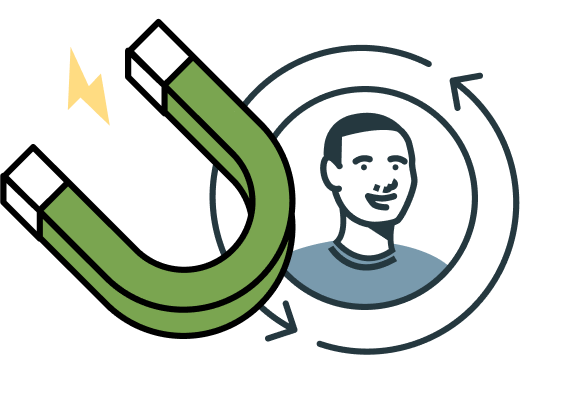
So you’ve hired AI & ML developers that are the right for your team and they’ve accepted! Now your focus should turn to setting the new team members up for success, and ultimately, retaining them over time.
Developers have an annual turnover rate of about 11.5% (and some sources going as high as 21%). They receive frequent recruiter outreach and may be less inclined to stick around when they’re not fulfilled or challenged by their role.
How can you nurture, train and engage your developers to keep them motivated and happy? Here’s a few strategies that have proven impact:
Strong developer onboarding
Organizations with supportive new developer onboarding create a positive experience for new engineers. To ensure a successful start, provide materials and equipment before their first day, schedule an immediate 1:1 with their manager, and set clear onboarding milestones for them to achieve.
| Why developer onboarding matters |
|---|
| 72% of employees say one-on-one time with their direct manager is the most important part of any onboarding process. Ritesh Patel, Co-Founder + CEO, The Ticket Fairy, agrees: “We actually have flown some [new employees] in for five days of onboarding with me in person – we’re looking for that really bought-in mission-driven team.” |
Training programs
The ever-evolving landscape of AI demands continuous learning. Platforms like Coursera and Udemy offer courses tailored for various AI competencies, from beginner to expert. Beyond this, you might also consider providing a budget for conference or event attendance, hosting accomplished AI / ML speakers, or providing mentorships with more senior engineering staff. The skills needed for AI development is changing quickly, so continued investment and upskilling will be a necessity.
Growth paths
Confusion over how to progress within an organization is challenging for any employee. Provide clear leveling plans for your eng org and communicate them clearly to each team member. Build regular manager check-ins (in addition to annual reviews) to understand each developer’s goals and build a plan to achieve them.
| Five tips for running effective remote teams |
|---|
| When hiring global AI engineers, you may start to see some common challenges of distributed teams, such as poor communication, lack of visibility and loneliness or isolation. Consider these tips to keep teams streamlined, connected, and effective. 1. Drive accountability: Set clear goals and establish mechanisms for the team to stay on track. Use focused blocks of time to minimize distractions and enhance productivity. 2. Keep processes simple: Regularly review and refine team approaches to avoid sticking to routines just for the sake of it. Ensure that processes serve the team effectively. 3. Document everything but quickly: Over-communication is key in remote. From code to company information, have documentation that’s accessible to all but quickly created. Overlong documentation processes can be draining, but critical documentation quickly created can accelerate teams dramatically. 4. Balance communication modes: Use a mix of synchronous and asynchronous communication. This allows for autonomy and efficiency without sacrificing the human connection essential for team cohesion. Incorporate great async tools like Slack, Jira, and GitHub. 5. Empower managers: Support and train managers to guide their teams effectively. This includes structured 1:1s, feedback mechanisms, and career pathing. 🎁 ✨ 🎁 BONUS RESOURCES for running remote teams 🎁 ✨ 🎁 Remote Teams Playbook Remote Management Guide Remote Retention Playbook |
Wrapping Up How to Hire AI & ML Developers
AI is one of the most sought-after specializations in modern engineering. Companies are in active competition to secure the best and the brightest engineers. Developing a thoughtful plan to source and hire AI & ML developers top talent may make or break your success.
You can put the right roadmap in place by crafting a compelling interview process, strong team structures and growth plans, and programs to nurture and support their development.
As you build your plan, remember: it’s not just about hiring the best; it’s about creating an environment where the best can thrive.
About Terminal
At Terminal, our mission is to push the world forward by bringing global opportunities to talent. Our goal is to break down geographical barriers, offering businesses an unparalleled edge by connecting them with top-tier AI and ML talent. As AI and ML domains continue to dominate the tech scene, partnering with a platform that understands your needs and provides access to global talent can be a game-changer.
For a deeper dive into our newest offering and to instantly view our AI developers for hire, sign up here, preview AI developer profiles, or contact our team.
